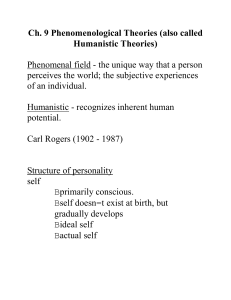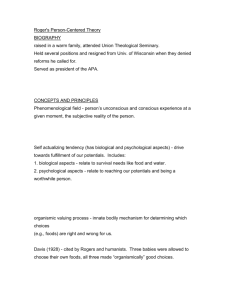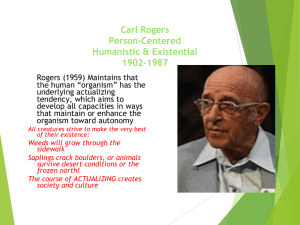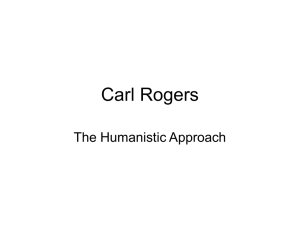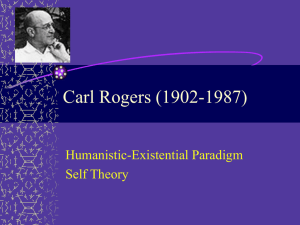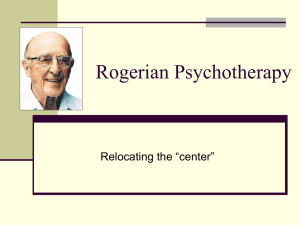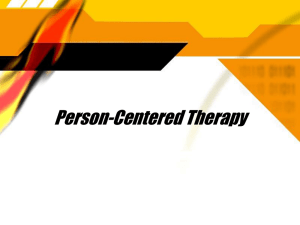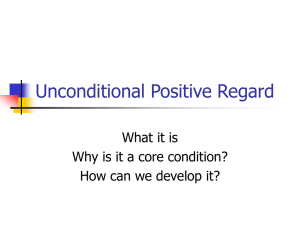Carl Rogers' Client-Centered Theory: Key Concepts
advertisement
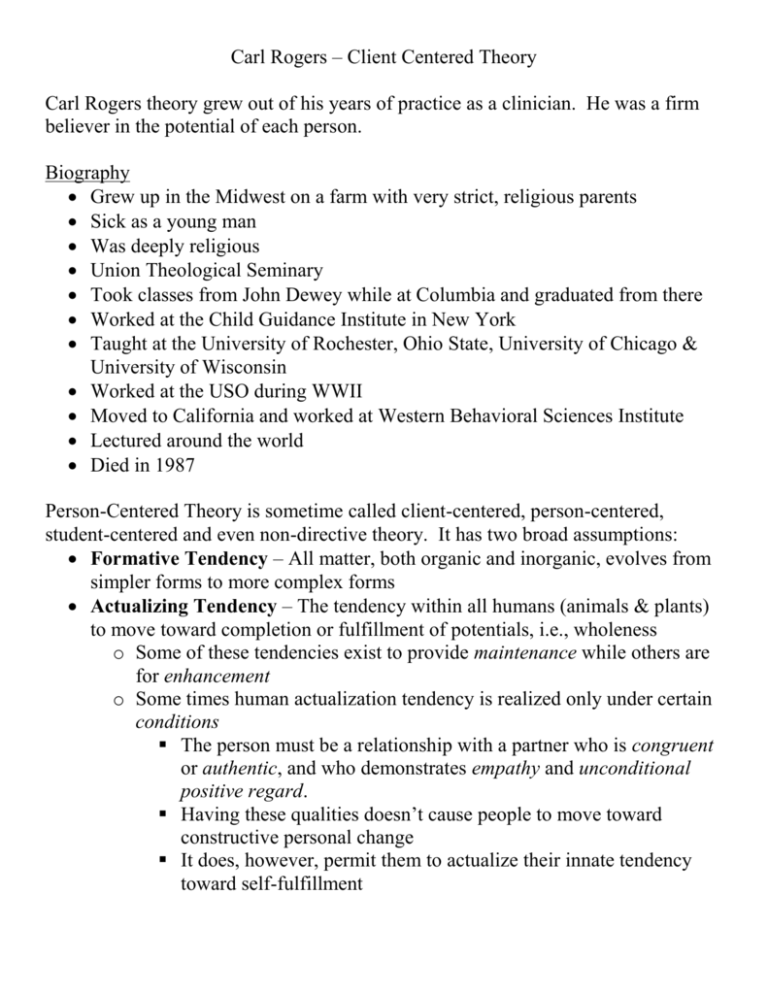
Carl Rogers – Client Centered Theory Carl Rogers theory grew out of his years of practice as a clinician. He was a firm believer in the potential of each person. Biography Grew up in the Midwest on a farm with very strict, religious parents Sick as a young man Was deeply religious Union Theological Seminary Took classes from John Dewey while at Columbia and graduated from there Worked at the Child Guidance Institute in New York Taught at the University of Rochester, Ohio State, University of Chicago & University of Wisconsin Worked at the USO during WWII Moved to California and worked at Western Behavioral Sciences Institute Lectured around the world Died in 1987 Person-Centered Theory is sometime called client-centered, person-centered, student-centered and even non-directive theory. It has two broad assumptions: Formative Tendency – All matter, both organic and inorganic, evolves from simpler forms to more complex forms Actualizing Tendency – The tendency within all humans (animals & plants) to move toward completion or fulfillment of potentials, i.e., wholeness o Some of these tendencies exist to provide maintenance while others are for enhancement o Some times human actualization tendency is realized only under certain conditions The person must be a relationship with a partner who is congruent or authentic, and who demonstrates empathy and unconditional positive regard. Having these qualities doesn’t cause people to move toward constructive personal change It does, however, permit them to actualize their innate tendency toward self-fulfillment o Rogers believed that when congruence, unconditional positive regard, and empathy are present in a relationship, psychological growth will invariably occur o These are necessary & sufficient conditions 1. As the individual develops the concept of self they become more aware or I or me experiences! 2. The person’s self-concept is the individual’s self-perception and their perception of their organismic self. 3. Dysfunction occurs when there are discrepancies between these two. 4. The ideal self is the view of one that one wishes to be 5. Sometimes there are discrepancies or incongruence between the ideal self and the self concept 6. The person may or may not have awareness. It can be: a. It may be denied or it may be ignored b. Or it can be accurately symbolized and freely admitted to the selfstructure c. Or it may be distorted How does one become a person? 1. The individual must make contact with another person 2. The individual develops a need to be loved, referred to as positive regard 3. Finally, the individual then develops a prizing or valuing of one’s self called positive self-regard What are the barriers to psychological health? 1. Conditions of worth (accepted “only if”) 2. Incongruence (between our self-concept and our organismic experience a. Vulnerability occurs when we lack awareness of our incongruence b. Anxiety occurs when we gain awareness (can be healthy) 3. Defensiveness is the protection of the self-concept against anxiety and threat by denying or distorting experiences inconsistent with it 4. Distortion is similar but it is a misinterpretation of experience in order to fit it into some aspect of our self-concept 5. Denial allows us to refuse to perceive an experience in awareness or keep some aspect of it from reaching symbolization 6. When defenses fail, the individual may be come psychotic or disorganized Psychotherapy The client-centered approach holds that in order for vulnerable or anxious people to grow psychologically, they must come in contact with a therapist who is congruent and whom they perceive as providing an atmosphere of unconditional acceptance and accurate empathy Not an easy task The counselor must be congruent which involves being aware of o Feelings of the client o Awareness of client o Expressions of the client Unconditional positive regard must be present Empathic listening is when the therapist accurately senses the feeling of their client and are able to communicate with the client in an open way Therapeutic change is a process that occurs in stages Rogers’s Theory of Therapeutic Change If the following conditions exist: 1. 2. 3. 4. 5. Then therapeutic change occurs and the client will A vulnerable or anxious client 1. become more congruent contacts a counselor who possesses 2. be less defensive congruence in the relationship 3. become more open to experiences unconditional positive regard for the, 4. have a more realistic client, view of the world and 5. develop positive selfregard empathic understanding for the client’s 6. narrow the gap between internal frame of reference, and ideal self & the real self 6. the client perceives Conditions 3, 4, & 5 - the necessary and sufficient conditions for therapeutic change Critique Generate research – 3 Falsifiability – 5 Organize knowledge – 5 Guide for the solution of practical problems – 5 Internally consistent – 5 Parsimonious – 4 O>P Free will > Determinism Causal < Teleological Unique > Similar Conscious > Unconscious Biological < Social 7. be less vulnerable to threat 8. become less anxious 9. take ownership for experiences 10. become more accepting of others 11. become more congruent in relationships with others.
